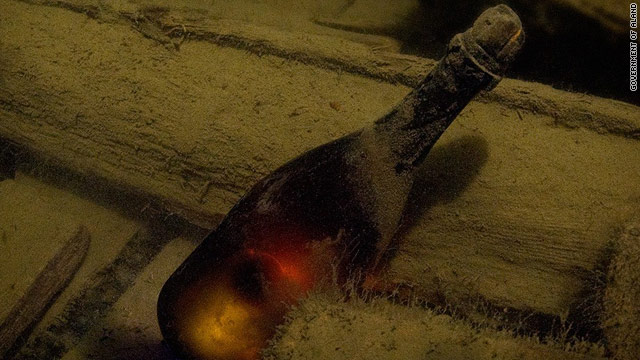Divers lift 200-year-old champagne from Baltic shipwreck

- About 70 bottles lie mostly undamaged south of the Aland Island
- "The first bottle was brought to the surface in mid-July," official says
- The champagne is believed to have been aboard the ship between 1800 and 1830
(CNN) -- Divers are recovering bottles of champagne that have been lying at the bottom of the Baltic Sea for about two centuries, an autonomous Finnish island official said Wednesday.
About 70 bottles lie mostly undamaged at 50 meters deep [roughly 164 feet] south of the Aland Islands.
"The first bottle was brought to the surface in mid-July," Rainer Juslin, permanent secretary of the island's ministry of education, science and culture, told CNN via telephone from Mariehamn, the capital of the Aland islands. "We believe this is the oldest champagne in the world."
Juslin said that the cargo was aboard a ship believed to be heading from Copenhagen, Denmark, to St Petersburg, Russia, between 1800 and 1830. It could have possibly been sent by France's King Louis XVI to the Russian Imperial Court.
"Champagne of this kind was popular in high levels [of society] and was exclusive to rich groups -- it was not a drink for common people then," Juslin said.
--Rainer Juslin
Juslin said some of the bottles already retrieved had some cracks and a few corks on the bottles had corroded, leaving the possibility open that "salt water leaked into some bottles ... but for the undamaged bottles, they could be very high quality [champagne]."
Some of the bottles were originally produced by Juglar, a premium champagne house no longer in existence, according to Juslin.
He said the cold sea water was a perfect way to store the vintage bubbly, with the temperature remaining a near-constant 4-5 degrees Celsius [around freezing temperature in Fahrenheit, or 32 degrees] and no light to expedite the spoiling process.
"This was the ultimate conditions for storage," Juslin said. "And it would never freeze."
Juslin speculated the ship carrying the cargo may have been Finnish or another Scandinavian ship.
The island chain is at the entrance of the Gulf of Bothnia, in the Baltic Sea, and is an island of Swedish speaking people, though the island itself falls under Finnish control.
The islands form an archipelago of more than 6,000 skerries and islands.
